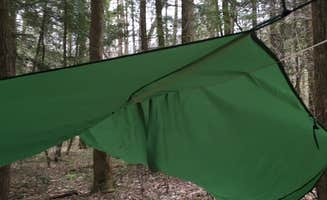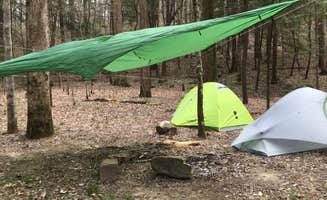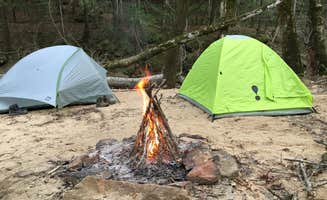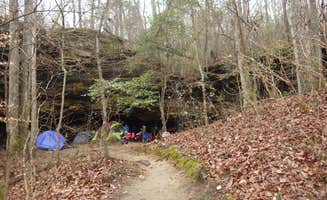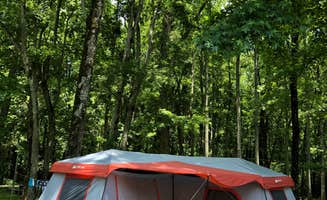Tent camping near Moulton, Alabama centers around Bankhead National Forest's Sipsey Wilderness, covering 25,000 acres of protected wilderness with over 45 miles of hiking trails across varied terrain. During spring, wildflowers bloom throughout the forest while fall brings cooler temperatures around 60-70°F, making these seasons ideal for backcountry camping. Water levels in streams and creeks fluctuate seasonally, with winter and early spring offering the highest water levels for filtering.
What to do
Hike to waterfalls: Thompson Creek Trail offers multiple waterfall access points within a moderate hike. A visitor noted that "The entire Sipsey Wilderness is gorgeous, but if you want a trail with lots of great spots to camp, this trail is fantastic... Most of the time, except during dry spells, there are LOTS of waterfalls. Also lots of shallow places for the kids to play in the water."
Explore intersecting creeks: Sipsey Wilderness Backcountry Site (Trail 207 Site B) offers access to multiple water features at creek junctions. "This particular campsite is located at the intersect of several streams and is a beautiful spot with a large area to set up tents... it is right along the water without the need to climb down any steep banks."
Rock formations viewing: Discover unique geology along Trail 206. One camper described the area as having "giant moss covered boulders all around, and cliffs in the background opposite the river. Most of the campsites have fire pits, and a few have some hand-made benches, usually from woven branches."
Seasonal water activities: Water levels vary dramatically by season. During wetter periods, shallow creek areas become perfect for wading, but kayaking requires specific conditions. Rangers advise "the only time that it was really navigable was in the winter or fall for a couple of days after a major rainfall."
What campers like
Sandy tent sites: Sipsey Wilderness - Trail 200 Campsites feature comfortable sandy soil for tent setup. One camper noted, "It has flat sandy tent spots up the hill and out of reach of flooding... Most of the site is pretty sandy but level which was wonderful for sleeping on."
Seclusion with water access: Backcountry sites balance privacy with convenience. "This site in particular is one of my favorites to stay at. It has several waterfalls nearby, is close enough to the river for easy water access, and is secluded from many other sites."
Year-round water sources: Owl Creek Horse Camp provides reliable water access when backcountry sources run dry. "Here you can find potable water from the spickets all year long. It is essentially a large field with some very large loblolly pines. The nights sky is wonderful."
Wildlife viewing opportunities: The wilderness area hosts diverse wildlife. Campers should "Watch for snakes and bring bug spray" while enjoying the natural surroundings.
Cell service in select areas: Unlike most wilderness locations, some campsites offer limited connectivity. One reviewer mentioned, "We enjoyed staying here after being out of cell service for a few days at brushy lake, so we were able to catch up and coordinate our next destination... 2 bars of Verizon 4G LTE."
What you should know
Trail navigation challenges: The wilderness designation means minimal maintenance. "The wilderness area is contained within the larger Bankhead National Forest and is accessible from a variety of different trailheads many of which are only reachable on dirt roads."
Water filtration necessity: Streams provide the primary water source, but treatment is essential. Thompson Creek Trail Campsites require visitors to "bring bug spray... Don't expect bathrooms or drinking water to be nearby, but if you're looking to really get away from it all and do some primitive camping, this is a great place to go."
Weather preparedness: Alabama weather changes rapidly. One camper noted they "did a backpacking trip with friends here in the middle of the summer and it sure was hot. Luckily though the rivers made for a great way to cool off."
Flooding risks: Many sites are positioned near water, requiring careful site selection. "The best sites are flood safe campgrounds that are good for spring... this site is one of the furthest along this section of trail and is nice since it is one of the larger spaces in this area."
Access road conditions: Forest roads can be challenging. As one camper reported, "The roads aren't the best but my van made it despite the muddy potholes."
Tips for camping with families
Select appropriate trails: Sipsey Wilderness Backcountry Site (Trail 203 Site C) offers family-friendly access. "The Borden Creek Trailhead where we started our hike used to be down at the bottom of the hill but several years ago they moved the parking to a quarter mile away... We loaded up all our gear into our hiking cooler and backpacking packs and trekked the 15-20 min downhill to this site."
Stream crossings with children: Consider height differences when crossing water. One parent shared, "The hike in is not difficult. You do have to cross a stream, which was not as difficult for my 6'2 husband as it was for me at 5'2. The water was clear."
Plan group sites accordingly: For multiple tents, seek larger clearings. "This site is by far the best site if you have a group of 3 or more tents. It has several firepits and is spread out over a large area. Each individual site has enough privacy while still providing group areas to congregate."
Short family outings: Even quick trips can create lasting memories. One parent noted, "Me and my 6 year old daughter hiked the trail this past Saturday. Had a great time. Definitely be back."
Tips from RVers
Limited RV accommodations: McDougle Hunt Camp provides basic facilities for small RVs. "This is another basic campground in the Sipsey wilderness area. The amenities are very limited but it gives you easy access to lots of amazing hiking in the area."
Consider nearby alternatives: When primitive camping proves too basic, other options exist. "The campground doesn't have much in terms of amenities but if you prefer a little more you can stay at Brushy lake nearby."
Trail access for day use: Even without overnight stays, RVers can access the wilderness. "The major advantage to this site is its access to the horseback riding trails... For people like me who are more hikers than riders you just drive 15 min down the road and you are right in the heart of Sipsey wilderness."
Cost considerations: Developed sites charge nominal fees. "Cost is $5 a night or $3 for day use" at Owl Creek Horse Camp, making it an affordable base camp option for day hikers.


